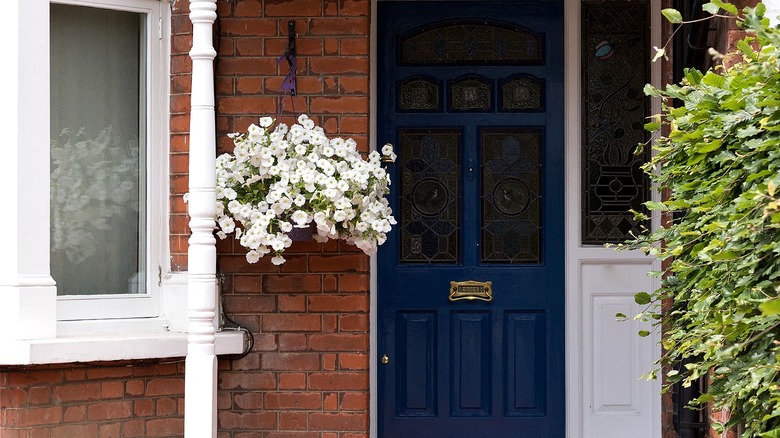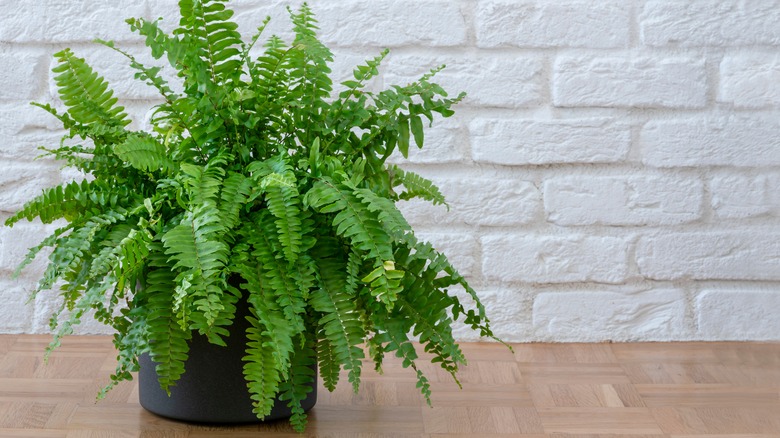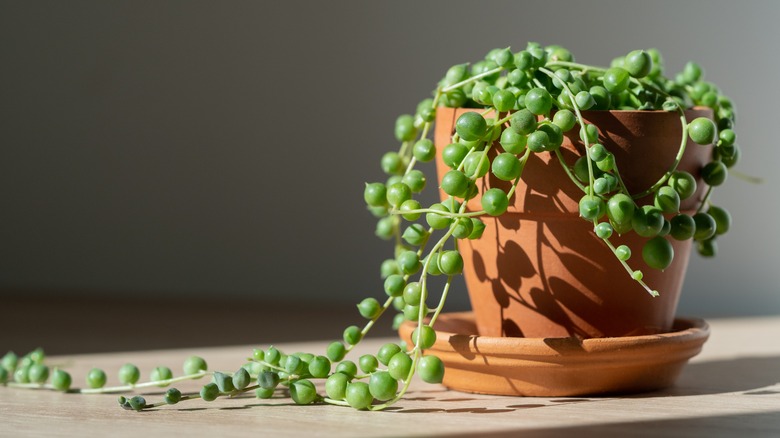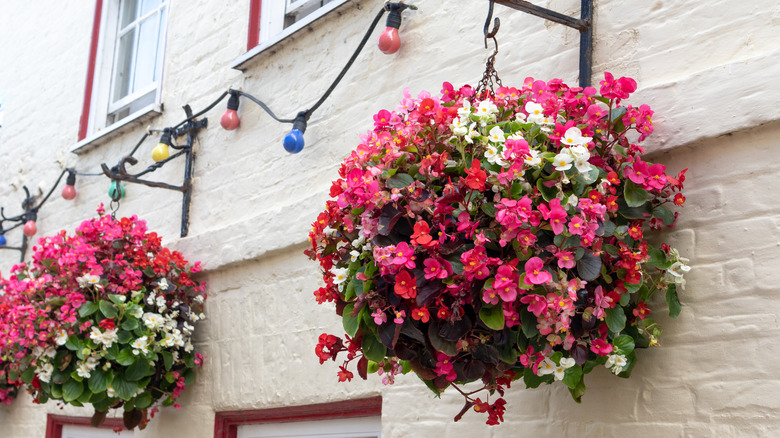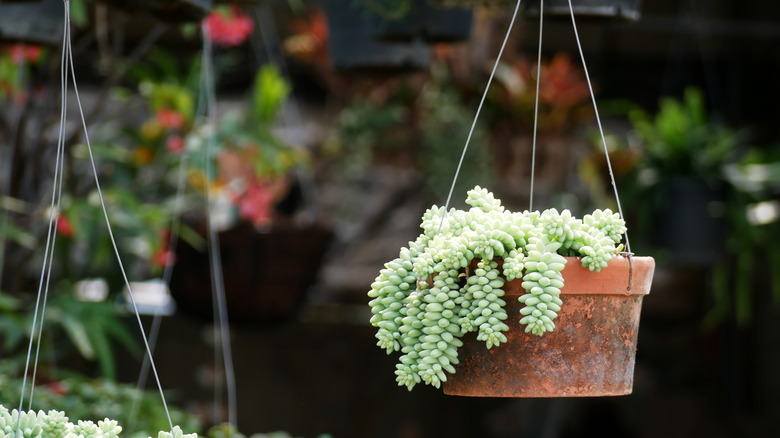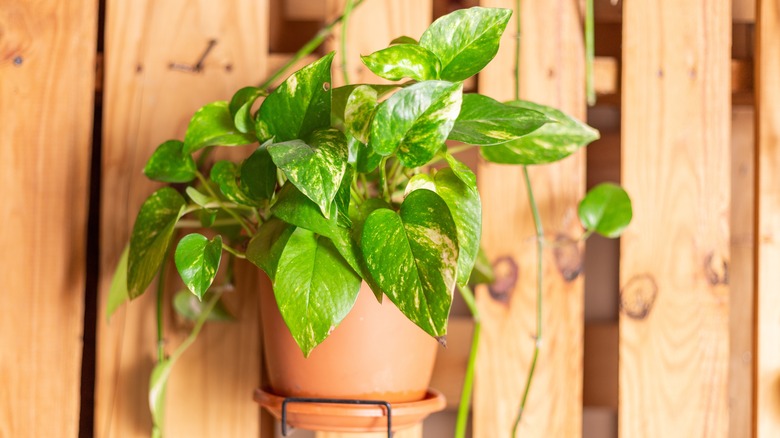5 Best Hanging Plants For Your Outdoor Space
Hanging baskets are a great addition to any outdoor space. They can bring color and dimension to your porch, patio, and/or garden. There are many different ways to style a hanging basket so it can fit with your home's decor. For example, you can choose if it's held by rope, plastic, or chains; and if the basket is made of wrought iron, plastic, or pottery. Hanging plants is helpful for small homes with limited space, so you can double the plants you grow. You can have a vegetable garden planted in the ground and pretty flowers or vegetation hanging above them. Even if you don't have space in your home to mount a hook, there are shepherd's hooks that you stake into the ground and hang your plants from.
Putting plants in a hanging basket has a small downside, however. Since it's not in the earth, the soil will dry out faster and need more frequent watering. However, Ambius explains that one way to help this problem is by putting your plant in a larger basket than it needs. Doing this will improve water retention, making your plants grow bigger and stay healthy.
Fern
Ferns are beautiful plants with big foliage that shoots out like feathers. They will add character to any home and are easy to take care of. They thrive with low light, making them perfect for hanging in a basket on your porch. There are many different species of ferns, but depending on where you live, you'll want one that is tropical or perennial, according to Costa Farms. A tropical fern will be the better choice if you live in a hot climate with high humidity. However, if you have cold winters, perennials will fit your local weather by being hardy and regrowing in the spring.
To care for a fern, you need to provide them with a lot of water. When you put it in a hanging basket, its roots will dry out quicker, so your fern may need multiple waterings a day. You'll know to up the frequency if the air has been extra hot, dry, or windy. These plants love humidity but don't need as much sunlight, or their foliage can burn.
String of pearls
String of pearls is a unique succulent that looks like beads cascading out of its pot. Since it's a trailing plant, it'll look gorgeous in a hanging basket. Depending on your location, you can successfully grow this plant outdoors. You need to be in a USDA Zone of 9 through 12, according to Garden and Happy. Otherwise, your winters are too cold for a string of pearls to stay alive. If this is the case and you really want to grow yours outdoors, move them inside when the temperature drops below 50 degrees Fahrenheit.
This plant thrives in the heat. It needs bright, indirect sunlight and hates cool breezes. Hanging a string of peals on your porch is perfect because it'll provide just enough shade to keep the sun from burning the foliage. Since it's a succulent, it needs well-draining soil to prevent root rot. It should get watered about twice a week in the summer and almost every week in the fall. Once winter starts, your string of pearls will need little to no water.
Begonia
Begonias have colorful flowers that bloom in the summertime. Their drooping foliage comes in various shades of green with pink, orange, red, yellow, or white flowers. This plant will climb or hang as it grows up to 3 feet long. Your patio or porch is a perfect place to put your begonias because they do best in partial shade to protect them from being burnt. Although they need quite a bit of sun, Plant Care Today recommends not putting them in the shade if you live in the Northeast. If you did, your plant wouldn't be able to bloom.
This plant does best in slightly acidic soil that is regularly fertilized. To thrive outdoors, it also needs warm weather with no strong winds. Begonia should get water about every two to four days. Although, if the weather is hot and dry, it'll need even more water. To promote more blooms and branching, make sure to pinch the plant's growing tips.
Burro's tail
Burro's tail is another different-looking succulent. Like its name alludes to, this plant's foliage looks like a tail, with densely packed leaves that look like knobs. This foliage is a good indicator of the health of the plant. If the leaves overlap, it gets the correct amount of sunlight and water. When the stems start to stretch and the leaves are less frequent, your plant likely needs more sun. It needs bright to full sun, but some shade will save it from being burned.
San Diego Magazine explains that burro's tail is a trailing plant that needs room to grow nice and long. Hanging them on your porch will do just that. They should be in a pot with holes and well-draining soil because they only need water once a month. Since they don't need water as frequently, the potting mix can clump together. You can aerate the soil by poking holes with a pen to fix this.
Pothos
Pothos is a popular houseplant, but if you live in the right area, you can move yours outdoors. This tropical plant can grow to its full potential when it's outside. If you're in a USDA Zone of 10 through 12, you can take advantage of the warmth and allow your plant to grow trailing vines up to 60 feet long. Pothos is a resilient plant that can live through neglect with low light and infrequent watering. However, it'll thrive with partial shade and warm weather. All About Gardening explains that one of the few things you can do to kill a pothos is leave it in the cold. Once the temperature drops below 45 degrees Fahrenheit, it's time to bring your plant indoors or cover them with a frost blanket.
They need well-draining soil that's very sandy and doesn't need water very often. Always check the top 2 inches of your plant's soil to see if it's dry. If it is, go ahead and give it some water. Pothos can go about two weeks between waterings. The better you treat your plant, the longer its vines will grow, and the bigger its leaves will become.
